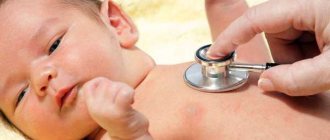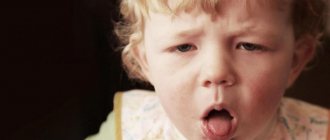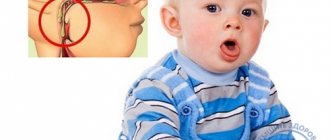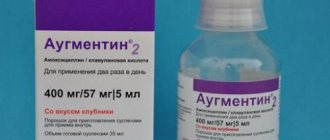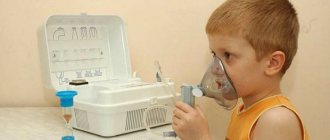What is special about children's antibiotics?
Should children be given antibiotics for colds?
Almost all parents ask this question when their child has a runny nose or cough. Pediatricians believe that antibiotics can be prescribed only after examining the child in a clinic.
Indeed, in some cases the use of these drugs is inappropriate. Unsystematic treatment with antibiotics contributes to disruption of the intestinal microflora and decreased immunity.
When should you take an antibiotic?
Antibiotics for children with a cough or runny nose are prescribed only in the case of a bacterial etiology of the disease. If the infection is caused by viruses, then the antibiotic medicine will be not only useless, but also harmful. This is due to the fact that the antibiotic suppresses local immunity, and since it does not have a detrimental effect on viruses, the disease can worsen.
We can talk about prescribing antibiotics if the following diagnoses are made:
- sinusitis: sinusitis, sinusitis and others;
- rhinitis;
- bronchitis;
- pleurisy;
- pneumonia;
- tracheitis;
- tuberculosis.
These diseases must be treated under the supervision of a doctor. Before prescribing antibiotics, the patient undergoes a mucus test. Laboratory tests reveal the type of pathogen and its sensitivity to antibacterial agents.
Only after receiving the result can the doctor prescribe exactly the drug that is best suited. However, there are many antibiotics with a wide spectrum of action that are prescribed without appropriate tests.
The presence of a bacterial infection can be determined by the following symptoms:
- elevated body temperature does not subside for more than three days;
- discharge of thick yellow-green mucus from the nose with rhinitis and sinusitis;
- severe and prolonged cough due to diseases of the throat, bronchi and lungs;
- sore throat and bad breath due to sore throat and pharyngitis;
- duration of the disease.
A viral infection can be suspected if, in addition to a runny nose and cough, headache, fatigue, weakness, nausea, vomiting and other acute symptoms are added. To combat viruses, immunomodulators, virus blockers and others are prescribed. Antibiotics are not prescribed for acute respiratory infections. These drugs do not cure the disease faster, but they can cause side effects in the form of allergies and dysbacteriosis.
If the doctor has diagnosed a bacterial infection, then the next step is to select the appropriate medication. There are several groups of drugs used to combat bacteria.
Varieties:
- Penicillins. The main effect of this group of antibiotics is to inhibit the formation of cell walls of microorganisms. As a result, bacteria lose their ability to grow and reproduce. Penicillins are able to penetrate the body's cells, making them useful for treating intracellular infections. The disadvantages of penicillin-based drugs are that they are quickly eliminated from the body, and bacteria easily develop resistance to them. The main side effects are an allergic reaction. Penicillins have virtually no effect on the human body, therefore they are considered the most harmless. Augmentin, Amoxiclav and Ampicillin are drugs that are often prescribed as an antibiotic for children with a cough or runny nose.
- Cephalosporins. The mechanism of influence of cephalosporins on bacteria is similar to penicillins (bactericidal effect). The main difference is that they can influence those microorganisms that show resistance to the previous group. Side effects also include allergic reactions. Known drugs: Cefalotin, Cefomandol, Cefoperazone.
- Macrolides. Macrolides have a complex cyclic structure. The action of antibiotics in this group is bacteriostatic. They block the very structure of bacteria, as a result of which they lose the ability to develop and reproduce. These are broad-spectrum antibiotics. Macrolides are capable of destroying even bacteria that do not have a cell wall. Among the well-known drugs are Azithromycin, Erythromycin, Roxithromycin. The medications are relatively safe and can be used to treat children and pregnant women.
- Fluoroquinolones. These are antibacterial agents, which, unlike antibiotics, do not contain a natural analogue. This group of medications inhibits enzymes in the bacterial cell membrane, leading to its death. Fluoroquinolones are prescribed for treatment in children in exceptional cases.
Basic rules for taking antibiotics for children with coughs and runny nose:
- Do not treat children with antibiotics yourself.
- Use only the antibiotic prescribed by your doctor.
- Penicillin antibiotics are usually used to begin treatment of cough. Release forms: tablets or suspensions. If they do not bring the desired effect, then another group of drugs is prescribed.
- If a child has an infection in the nose, then treatment should be local. To do this, use drops and sprays with an antibacterial component.
- A child should be treated with antibiotics in a course course. Do not stop giving the medicine earlier or extend the period recommended by the doctor.
- For treatment at home, you can use the following dosage forms: powders for preparing suspensions, syrups, sprays, drops. Antibacterial injections should be given in a hospital setting.
Only a doctor should choose an antibiotic for a child. Among the most frequently prescribed drugs are Amoxicillin, Amoxiclav, Zinnat, Sumamed, Flemoxin Solutab, Ceftriaxone, Augmetin. To treat cough, children are usually prescribed syrups.
Among them there are drugs that are combined with antibiotics:
- Lazolvan. Can be taken simultaneously with antibacterial agents, provides an expectorant effect.
- Bronholitin. It is considered one of the most effective cough medicines. It contains plant components that enhance the effect of the antibacterial agent.
- Dr. MOM. Works well for dry cough. The medicine easily eliminates coughing attacks, thanks to herbal components.
A children's antibiotic for coughs and runny noses, when taken simultaneously with syrup, acts faster and more effectively. After taking the medications, the child feels easier breathing, his shortness of breath stops and coughing attacks decrease.
In addition, antibiotics reduce body temperature and other unpleasant symptoms. When choosing an antibiotic for a runny nose, you need to be sure that the disease is caused by pathogenic bacteria.
Among the well-known drops and sprays for the treatment of rhinitis and sinusitis are the following:
- Novoimanin;
- Isofra;
- Bioparox;
- Framycetin.
Medicines with antibiotics for a runny nose orally or intramuscularly are used only for severe pathologies.
Medicines designed to combat pathogenic microflora can quickly and effectively defeat the disease when the child’s body cannot cope with the infection on its own. If a runny nose or cough lasts a long time and has a bacterial etiology, no other syrups, drops or sprays will help.
Antibiotics promote rapid recovery, but also have disadvantages. Among the side effects, allergic reactions are common. A child’s cough may even get worse due to an allergy that has arisen in the mucous membrane of the larynx (irritation). Other side effects include disruption of the intestinal microflora and decreased activity of the immune system.
Strong antibiotics taken orally for a long time have the most negative effect on the body. An antibiotic for a runny nose acts at the local level, so it does not disturb the natural balance in the body. Despite the negative consequences for the body, children's antibiotics for coughs and runny noses are necessary when pathogenic microflora actively multiply in the respiratory tract.
After treatment, the doctor prescribes medications that will help restore the microbiome and immune system. To do this, take biological supplements (probiotics), vitamin-mineral complexes, and herbal syrups. On forums, parents often discuss the question of whether it is possible to replace antibiotics with folk remedies.
Among the remedies that relieve coughs and runny noses, popular are decoctions of medicinal herbs, a chest compress made from badger fat, inhalations with potatoes, mustard wraps and much more. But it is important to remember that serious infections should be treated under medical supervision. Therefore, it is better to consult a pediatrician about methods of additional treatment.
A child's cough can occur for various reasons. But it makes sense to use antibiotics if the cough was caused by a bacterial infection. You should also understand that antibiotics are very powerful drugs that cause serious damage to the body, so such tablets should only be used in case of a severe cough that does not go away for more than 2 weeks. The use of antibiotics to treat cough is contraindicated in the following cases:
- If the child is sick with a viral or fungal infection. It should be understood that antibiotics can only kill bacterial microorganisms, but they cannot fight viruses and fungi. Antibiotics are not used to treat sore throat, flu, laryngitis, tonsillitis, and so on.
- If the cough is caused by an allergy. Cough can also appear due to allergies, and allergies should be treated with antihistamines.
- Also, antibiotics cannot be used to treat a cough if it appears due to mechanical damage to the respiratory system.
Doctors advise adhering to the following rules when taking pills:
- The selection of tablets should be carried out by the attending physician. It is prohibited to prescribe antibiotics for yourself or your child.
- The tablets should be taken at regular intervals. Let's say you are prescribed to take pills 3 times a day - in this case you need to take pills every 8 hours.
- You cannot change your medication schedule. If your child takes medications for more than 5 days, and no visible improvements are observed, then you need to additionally consult with your doctor, but you cannot stop taking antibiotics on your own! Another situation is also possible: the child was prescribed to take medication for 2 weeks, but the cough went away on the 3rd day of taking it - in this case, you also need to consult a doctor, and it is forbidden to stop taking the pills on your own.
- Be sure to pay attention to the expiration date and release date of the tablets. Do not give your child expired antibiotics as these medications can harm the liver and kidneys.
- It is important to take antibacterial drugs hourly, since each drug has its own period of action. Each subsequent dose will maintain the desired concentration of the drug in the blood, affecting the bacteria.
- It is unacceptable to change the dosage prescribed by the doctor. If you give your child the drug in a smaller dose, the treatment will be ineffective and may result in the development of resistance to the drug. Increasing the dose will not help cure the disease faster, but can cause an allergic reaction and the development of various side effects.
- You cannot stop taking an antibiotic before your doctor prescribes it. If the pediatrician said to take the medicine for 7 days, and already from the 3-4th day the child feels much better, the antibiotic still needs to be taken for the entire 7 days in order to prevent the resumption of symptoms of the disease and the emergence of resistance of the pathogen to the drug used.
Children are given antibiotics, strictly following the instructions prescribed by the doctor.
What is an antibiotic
Antibiotics mean special medications made from natural or synthetic ingredients. The main task of any antibiotic is to suppress the vital activity of fungi and bacteria that enter the body. These foreign substances become causative agents of serious diseases, which often occur with complications.
If the disease is viral in nature, antibiotic-based drugs are powerless and ineffective when prescribed. Antibiotics treat only bacterial and infectious diseases. At the initial stage of the disease, they try not to resort to such a potent method of influence.
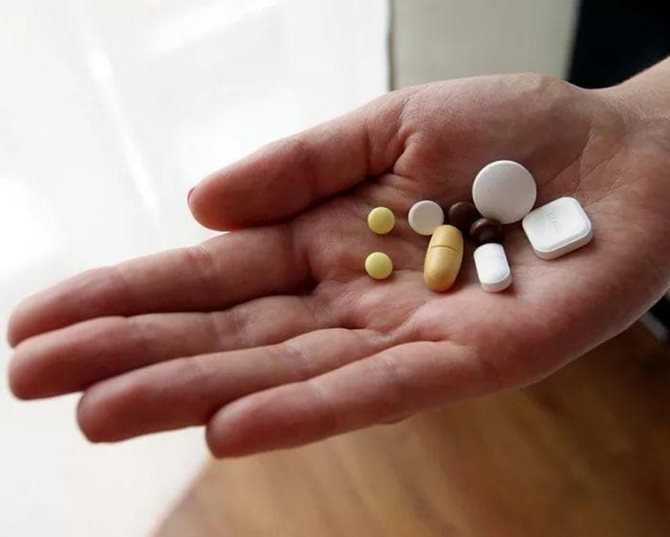
Reference! The use of antibiotics is justified in case of complications from the disease and the impossibility of cure by other more gentle methods, including various drugs and medications.
What antibiotics can be given for coughs in children without fever?
| Name | Features of application | Doses |
| "Amoxicillin" | For treating children of any age. Used as a suspension for up to 5 years. Use with caution in cases of renal dysfunction or increased bleeding. | · up to 24 months – 20 mg/kg per day, taken in three doses. · 2-5 l – 125 milligrams, divided by 3 times. · 5-10 years – 250 mg in three doses. |
| "Oxacillin" | Available in pills and powders for injections. Can be used for newborns. | The dosage is calculated according to the formula - 20-40 mg/kg. Children up to forty kilograms are usually given a quarter or half of a pill at intervals of 4-6 hours. For larger weights, 1-2 pieces every 5 hours. |
| "Augmentin" | Broad-spectrum agent. Tablets and powders are available for preparing suspensions and injections. | For newborns up to 2 months, the medicine is used only in extreme cases. From 7 to 12 years, as well as with a body weight of 22-40 kg, - 10 milligrams. In severe cases of the disease, the dosage is doubled. In tablets for a weight up to forty kg - 1 pill of 250 milligrams daily or three of 125 mg in 3 doses. |
Antibiotics for coughs in children, their names are listed above, are low-toxic and belong to the penicillin series. However, they are difficult to combine with other medications. The products often cause allergic reactions. The group of macrolides is most often used. For children, products based on azithromycin are selected - “Azitrus”, “Sumamed”. For bronchitis and pharyngitis, Clarithromycin and Erythromycin can be prescribed.
The temperature does not drop to 38 degrees. First, the body produces antibodies on its own. If the baby’s condition does not improve and the disease progresses, antibiotics are required for coughs in children with fever.
| Name | Features of application | Doses |
| "Flemoxin Solutab" | Created on the basis of amoxicillin, it has a sweetish taste. The pills can be swallowed, chewed, or dissolved in any liquid. | To prepare the syrup, take 20 milligrams of liquid per capsule, for the suspension – 100 ml. From 1 to 3 liters - 125 mg three times a day or 250 milligrams divided into two doses. At the age of 3-10 years - 375 milligrams every 12 hours or 250 with an interval of 8 hours. Children older - 500-750 milligrams twice, every 12 hours or 375-500 mg with an interval of 8 hours. |
| "Suprax" | One of the strong drugs is made on the basis of cefixime. A suspension is being prepared for the treatment of children. "Suprax" is contraindicated in infants under 6 months. | · 6-12 months – 4 milliliters daily; · from two to five years – 5 ml/d; · up to 11 years – 6-10 milliliters per day. Older children are given 400 ml daily. The duration of treatment is no more than 10 days. |
| "Sumamed" | A strong medicine from the macrolide group. Children are given a suspension. | Dose calculation depends on body weight - 10 mg/kg. The medicine is taken daily, one time at a time. Used one hour before feeding or after, 2 hours later. |
"Ecoclave" is a new generation combination drug with a wide spectrum of action. Produced in pills and powder for suspension. The daily dose calculation for infants up to three months is 30 mg/kg body weight. It is given in two times. For children from 3 months to 12 years old with chronic diseases, the dosage is calculated according to the formula 20 milligrams per kilogram of weight, divided into three doses. The amount of 40 mg/kg is given for acute infectious diseases.
In severe cases of the disease, the medicine can be administered by injection. A solution is prepared for this. Children under 3 years of age are given an oral suspension. Most often used:
- "Amoxicillin" broad-spectrum action from the penicillin group. The suspension is intended for the treatment of children. Ospamox is produced based on amoxicillin. Children 1-3 g are given 2.5-5 ml every 12 hours.
- "Sumamed" is used only from the age of two. Has a minimum of side effects. Taken daily, once. The course of treatment is 3 days.
- "Suprax" is a very effective remedy, used if other medications are ineffective. Used in extreme cases, can be used to treat infants.
- "Zinacef" belongs to the cephalosporin group. Mostly injections are made into veins or muscles. Use with caution to treat premature babies and newborns. Used from 3 months of age. Up to three years it is given in the form of a suspension. The required amount is calculated using the formula 20 mg/kg body weight.
"Ceftriaxone" is a broad-spectrum agent. This is a powder for preparing injections. Use 20-80 milligrams/kg daily.
For the treatment of children under 5 years of age, Klacid can be prescribed. This is an effective American drug. For children it is available as a powder; it is the basis for a suspension. The prepared solution can be used within 14 days. The suspension is given from six months. Children under 12 years of age are prescribed 7.5 mg/kg twice a day. Duration of use is 1-1.5 weeks; for pneumonia or bronchitis, medication can be extended up to three.
Pancef is produced by a Macedonian company. The remedy is given only from six months. Up to 12 years of age, a dose of 8 mg/kg per day is indicated. You need to take the medicine twice a day, at equal intervals. The course of therapy is from a week to 10 days.
"Vilprafen Solutab" is an effective drug of the macrolide group. It cannot be used to treat premature babies. Use with caution if they have diabetes. For children under 14 years of age, 30-50 mg/kg is indicated. It is taken in three doses. The course of treatment cannot exceed 10 days.
Many medications are indicated for children under 6 years of age. For example, Augmentin is used for 24 months, the required amount for a weight of 13-21 kg is 5 ml. If a severe degree of the disease is observed, this figure is multiplied by 2 times. Antibiotics for coughs in children, names:
- "Ospamox" is given to children from 3 to 6 years old, twice a day, 5-7.5 ml.
- "Ecomed" is prescribed in the form of a suspension, only from six months. The solution must be made just before use. The required amount is calculated using the formula 10 mg/kg body weight. The medicine is given once a day for three days.
- Macropen is used from birth, in pills only from 3 years of age. The required amount is determined by body weight 30 mg/kg. Your doctor may prescribe two or three times a day.
- "Clarithromycin" belongs to the group of macrolides. Available in powder and tablets. A suspension is made for children. Pills are not given to children under 12 years of age. Typically prescribed is 7.5 mg/kg daily. The maximum allowed dose is 500 milligrams. The course of treatment is no more than ten days.
"Rulid" is a semi-synthetic drug from the macrolide group. It has low toxicity and can be used for children. The required amount is calculated using the formula 5-8 milligrams/kg per day. You need to take the medicine with plenty of water.
An antibiotic for cough and fever is not always prescribed. It must be prescribed by a doctor, since a strong drug, instead of the expected benefit, in some cases can cause harm to the body.
In order to understand when to take antibiotics for a cough and fever, you should know that these medications are antimicrobial and antibacterial. Their action can be directed at one or several groups of bacteria. Their main purpose is to reduce the growth of microbes or cause their death. In some cases, mild anti-inflammatory drugs can cope with this task.
Antibiotics for cough and fever are prescribed when it comes to bronchitis or pneumonia. Sometimes the first disease can be cured without them. Therefore, antibiotics for bronchitis are indicated for use in the advanced stage of the disease, with severe obstruction, and also if the temperature does not go down and lasts more than five days.
Cough with pneumonia requires mandatory use of antibiotics. This disease is very dangerous and can lead to the development of pulmonary edema. Therefore, it is usually treated inpatiently. In addition to antibacterial drugs, patients are also prescribed antitussive medications aimed at removing phlegm from the lungs.
For purulent or follicular sore throat, patients are also prescribed antibiotics. In this case, the temperature may remain high for five to six days, even if a strong antibacterial drug is taken. There may be no cough with tonsillitis. If it does exist, then separate medications are not required to get rid of it, since it occurs due to severe soreness and scratching in the throat.
Before we talk about what antibiotics to take for a cough and high temperature, it should be clarified that if the cause of these symptoms is a viral infection. After all, the substances contained in their composition are powerless in this situation.
For bronchitis, the patient is often prescribed Amoxicillin or Azithromycin. The latter is also sold in pharmacies under the name "Z-factor". For pneumonia, broad-spectrum tablets or injections are prescribed, for example, Cefazalin or Sumamed. For deep tracheitis or non-viral tonsillitis, patients are prescribed Flemoxin or Amoxiclav.
The names of antibiotic drugs are provided for informational purposes only. They must be prescribed by a medical specialist.
Treatment of cough, regardless of the cause of its occurrence, as well as the presence of accompanying symptoms, is carried out with one drug. Changing it is possible only if there is no positive dynamics of treatment, and only a doctor can prescribe a new drug. Most often, for children's cough, broad-spectrum antibacterial medications are prescribed, which have a negative effect on various pathogenic microorganisms.
Prescribing a highly targeted drug is difficult to determine the type of pathogen. This type of analysis is not available in every clinic, and the waiting period can be up to two weeks, which can become a critical moment for the child’s body.
Top 10 antibiotics from the pharmacy
Antibiotics for coughs in children without fever are used for oral administration and inhalation. In the latter case, the drug is injected into the respiratory ducts. Antibiotics destroy harmful microorganisms, stabilize the intestinal microflora, and prevent the occurrence of dysbacteriosis.
Inhalations are carried out using a nebulizer if the child does not have pneumonia or tuberculosis. The air mixture enters through the mask. Antibiotics are used more often than inhalations. The duration of the session and dosage are determined by the doctor.
Augmentin
Antibiotics for coughs in children without fever, belonging to the penicillin group, such as Augmentin, act on gram-negative and gram-positive bacteria. The antibiotic is produced in tablets, powder for the preparation of suspensions and powder for intravenous administration.
The tablets contain:
- clavulanic acid;
- silicon dioxide;
- magnesium stearate;
- amoxicillin;
- microcrystalline cellulose.
The drug has a bactericidal and antibacterial effect. Amoxicillin and clavulanic acid are almost 100% absorbed from the gastrointestinal tract when used.
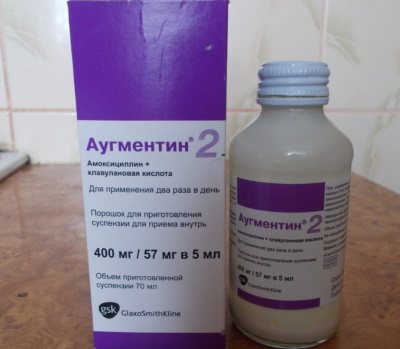
Indications:
- soft tissue and skin infections;
- respiratory tract infections;
- infections after surgery.
Contraindications:
- allergic reaction to drug substances;
- kidney diseases;
- age up to 12 years.
The drug is prescribed 1 tablet 3 times a day.
The course of treatment is 5 days. The medicine is taken before meals with a small amount of water. The product is available in pharmacies with a prescription and its price starts from 350 rubles.
Ampioks
A combined broad-spectrum antimicrobial drug that has a bactericidal effect. The product contains ampicillin and oxacillin, properties of which allow the solution and tablets to be used in various medical fields. The product is produced in capsules and powder for preparing a solution.
Both types of drugs contain:
- potato starch;
- talc;
- magnesium stearate;
- sucrose.
The action of Ampiox is based on the action of ampicillin, which inhibits transpeptidase in the microorganism. As a result, the synthesis of a key enzyme designed to strengthen the membrane is disrupted.
After use, the product is absorbed in the small intestine and reaches maximum levels in the blood after 2 hours. Its active components bind to blood proteins and are distributed evenly. The drug is excreted from the body through the urinary system.
When are antibiotics needed?
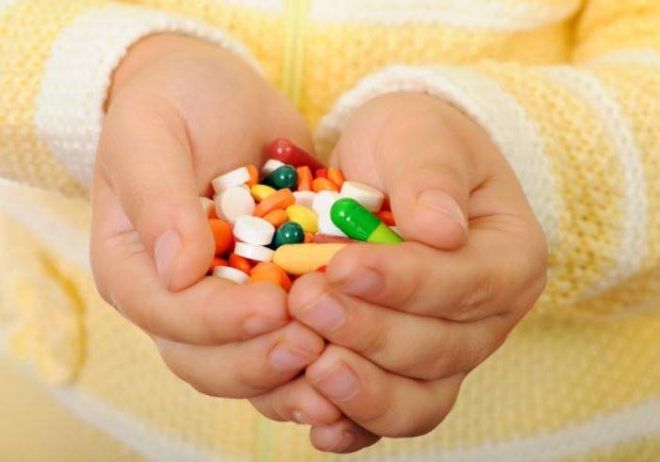
Let's find out what diseases are treated with antibiotics:
- Pneumonia. With pneumonia, a cough occurs due to inflammation of the lungs.
- Angina. With a sore throat, a cough is caused by phlegm forming in the throat, which makes breathing difficult.
- Bronchitis. In this case, the cough appears due to inflammation of the bronchi.
- Tuberculosis. With tuberculosis, there is a slow destruction of the respiratory organs, which over time leads to the appearance of a cough.
- Also, the use of antibiotics may be justified for whooping cough, purulent tracheitis, pleurisy, and so on.
Causes of coughing in infants
Snot and cough in infants are constant companions of respiratory infections. However, they do not always indicate pathology. In some cases, these symptoms are temporary and go away on their own.
A doctor can determine the exact cause of their occurrence, so parents should first contact him.
Norm
If a baby develops a runny nose and cough without fever, especially in the first days after birth, this is considered normal. This is how the baby adapts to the new environment. The glands that are located in the nose cannot yet secrete the required amount of mucus. Its excess flows into the throat, causing spasms. After a couple of days, these symptoms disappear without any treatment.
Transparent snot in infants from 6 months is also not dangerous. This runny nose can cause a cough. This is the time when teeth begin to erupt. These symptoms are normal and usually go away within 3-4 days.
A runny nose and cough can appear in children in the first months of life due to frequent and excessive regurgitation, dry and too warm indoor air, and hypothermia. Such attacks with a runny nose do not cause serious complications in infants. Treated with symptomatic means.
The norm is a cough that continues after treatment of diseases of the upper and lower respiratory tract. For example, after bronchitis, attacks in infants can last for a month. As inflammation decreases, spasms become less frequent and gradually disappear.
Pathological
Cough from snot in infants often occurs due to the fact that pathogenic microorganisms enter the mucous membranes. Sometimes there is no temperature, which complicates the diagnosis. Snot and seizures can be provoked by:
- Bronchial asthma. Accompanied by severe coughing attacks, especially at night and in the morning.
- Pharyngitis, laryngitis - inflammation of the upper respiratory tract. It is characterized by frequent, intermittent breathing with whistling, as well as a barking cough with a runny nose.
- Rhinitis. If caused by viruses, the snot is clear and liquid. When rhinitis is caused by a bacterial infection, nasal discharge is yellow-green and viscous.
- Whooping cough, diphtheria. In the first 2 days after the onset of the disease, only a severe cough is observed, which is subsequently supplemented by fever.
- ARVI and acute respiratory infections. A baby who is sick has a runny nose, congestion, and a wet cough.
- An allergic reaction is the body’s response to exposure to an allergen (pollen, animal hair/saliva, dust, household chemicals, cosmetic products, food). There is a runny nose (clear discharge), which leads to cough, skin rash, redness of the eyes.
- Entry of a foreign body into the respiratory tract. This leads to irritation of the mucous membrane, which causes reflex spasms.
My child has a severe cough (frequent), can you tell me if I can take antibiotics without a doctor?
A doctor should prescribe a particular antibiotic for cough treatment. To select the right medicine, the doctor may conduct additional diagnostics. Most often, the following types of antibiotics are used to treat children and adults:
- Macrolides. They are characterized by low toxicity to the human body, so they are most often prescribed for the treatment of bacterial infections. The following macrolides are approved for use by children: Sumamed, Azithromycin, Klacid and others.
- Cephalosporins. They are effective only against staphylococci, streptococci and some other microorganisms. They are quite toxic, so they should be used only when absolutely necessary. Children are allowed to take the following cephalosporins - Cefixime, Cefuroxime, Zinacef and so on.
- Penicillins. They are effective against almost all harmful bacteria, and the toxicity of these drugs is quite low. Penicillins are ideal for treating cough in children. Examples of medications for children are Amoxicillin, Amoxiclav, Flemoxin and so on.
- Fluoroquinolones. Fluoroquinolones are very effective against almost all bacteria, but these drugs are rarely used due to the fact that they are very toxic (for example, the use of fluoroquinolones can cause damage to osteochondral tissue). These medications are very rarely prescribed to children. Examples of drugs are Ciprofloxacin, Enoxacin, Tarivid and others.
- Tetracyclines. These medications are prohibited for children due to their very high toxicity.
If your child has a cough, you should visit a doctor. If the doctor does not prescribe the use of antibiotics, then you cannot buy antibiotics yourself. Let us remember that antibiotics are very toxic drugs that affect the functioning of the liver and kidneys. Also, with frequent use of tablets, a child may develop resistance.
The ineffectiveness of using an antibiotic for cough may be due to:
- Failure to comply with the required dosages.
- Interruption of treatment (missed doses).
- Inappropriate medicine (does not act on the pathogen).
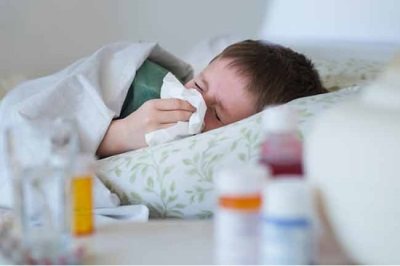
If the child’s condition does not improve within 2 days, the drug should be changed.
What antibiotics can a doctor prescribe for a cough?
It is best if, before choosing a drug, the doctor receives the results of a bacteriological examination of sputum and a smear from the child’s larynx and nose. Then the specialist will know for sure which bacteria caused the disease, and which antibiotic to “put in the line of fire” against them. But analysis of this kind is not carried out everywhere, and laboratory technicians take a long time to report the results - from 10 to 14 days. As we understand, neither the sick child, nor his concerned parents, nor the doctor have these two weeks. Therefore, doctors try to prescribe new generation broad-spectrum antibiotics for children who cough.
To treat cough, monotherapy is usually chosen - that is, one, usually relatively weak, antibiotic is used. If there is no improvement within 4-5 days, the doctor will change the drug to a more potent and effective one. The doctor will prescribe a stronger antibiotic (for example, from the cephalosporin group) even if the child has recently been treated with weaker antibiotics (for example, penicillin).
For children from birth to 3-4 years old, an antibiotic will be recommended in the form of a suspension, which is popularly mistakenly called “syrup” or in drops. Children from 5 to 10 years old can be given the medicine in tablets, and teenagers can take the medicine prescribed by the doctor in capsules.
For all ages, with severe disease, antibiotics can be prescribed in the form of injections - intramuscular or intravenous injections.
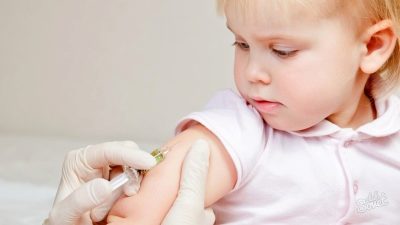
List of antibiotics most often prescribed to children for cough:
source
Antibiotics for inhalation
To treat a cough, your doctor may prescribe inhaled antibiotics. For inhalation, special inhalers and nebulizers are usually used. The main advantage of this method of treatment is that the antibiotics go directly to the site of inflammation.
The fact is that when taking drugs orally, antibiotics very often destroy the beneficial intestinal microflora, which can have a negative impact on human health. To carry out inhalations using a nebulizer, the drug is dissolved in water and filled into the device; After this, the dissolved medicine is heated, and the patient then inhales the medicinal steam. Below we look at three antibiotics that are used to treat coughs using inhalation.
Dioxidine
Typically, dioxidin is used to treat coughs that appear as a result of damage to organisms by staphylococci, streptococci and pyogenic bacteria. For a long time it was believed that this medicine was very toxic, so dioxidin was contraindicated in children. However, about 10 years ago, many studies were conducted that showed that this antibiotic is not too dangerous, so it can be prescribed to children. This medicine is usually available in the form of a solution for inhalation.
Treatment with dioxidine looks like this:
- If a 0.5% solution of dioxidine is used for treatment, then for treatment, dilute this medicine with saline solution in a ratio of 1 to 2.
- If a 1% solution of dioxidine is used for treatment, then for treatment, dilute this medicine with saline solution in a ratio of 1 to 4.
- The medicine diluted with saline solution can be stored in the refrigerator for no more than 12 hours.
- If the child is under 6 years old, the duration of inhalation procedures should be 1 minute; if the child is over 6 years old - 1-2 minutes.
Ceftriaxone
Ceftriaxone is a very powerful medicine; It is used to treat cough in children if the child has a high fever, vomiting, weakness and other disorders. The release form of ceftriaxone is powder for inhalation. To prepare the medicine, the doctor dilutes the powder with water for injection in a ratio of 1 to 5.
Streptomycin
Streptomycin is commonly used to treat diseases such as whooping cough, bronchitis and pneumonia. This medicine should not be taken by children under 3 years of age. The release form of streptomycin is dry powder for injection. To treat cough with streptomycin, you need to dilute the powder with water for injection in a concentration of 1 to 4. The solution must be prepared each time before use. The duration of one treatment session is 2-3 minutes.
What drugs are prescribed by age (up to one year, up to three, up to 7 years, up to 10)
Children up to one year old are prescribed antibiotics made in suspensions. This form is the most suitable, since the swallowing reflex in babies is poorly developed. To prepare the solution, take a syringe with a measuring division. As a rule, it comes with the medicine. And they put 12 ml into it. boiled water. Add to tablet or suspension mixture and shake well. Store in the refrigerator for no more than 5 days between doses.
From birth, until the baby is one year old, it is allowed to give penicillin antibiotics, since they have little toxicity. They can be used for scarlet fever, tonsillitis, skin infections, acute sinusitis, otitis media.
For example, Amoxicillin can be used up to 5 years of age. One measuring spoon contains 5 milliliters of suspension and 250 milligrams of amoxicillin. Dosage for children under 2 years of age – no more than 20 mg/kg/day. Amoxicillin is used alone or in combination with clavulanic acid.
Augmentin has a wide range of applications. For newborn babies, the dosage should be carried out strictly according to the instructions. You can also give Amoxiclav for up to a year.
Macropen, Azithromycin and Sumamed are available in tablet form, so they are suitable for treating older children. From the age of three it is quite possible to prescribe them. Isofra, EcoClav, Polydexa are prescribed to children from three to seven years old. Ospamox, Meronem, Klabax are allowed to be given to children under 10 years of age.
We recommend: Bepanten for children - instructions for use
What cough antibiotics does Komarovsky recommend?
Komarovsky does not advise parents to immediately give their children pills. The doctor believes that medications can cause more harm and there is no need for them. All of them can be easily replaced with natural remedies. If medication is necessary, a cold can be treated with two medications.
Libexin is produced in powder and tablets. Prescribed for laryngitis, flu, pharyngitis, etc. The product is used for non-productive cough. The dose is calculated based on body weight. On average, a quarter or half of a pill is given daily, at a time.
"Sinekod" is used to treat all types of bronchitis. The product in drops can be given only from 2 months. Age treatment regimen:
- up to 12 months, dissolve 10 drops, drink 4 doses per day;
- 1-3 g – 15 k each;
- from three to 12 – 25 kopecks each.
The medicine in the form of syrup is given to children from three to six years old - 5 ml three times with an interval of 8 hours, for older people the dose is doubled.
Antibiotics for coughs in children, the names of which are classified as tetracycline and fluoroquinol groups, are contraindicated up to 8 liters. You cannot choose any medications yourself. The required amount for therapy is determined only by the doctor. You can read reviews on this topic or write your opinion on the forum.
Read more on the topic:
